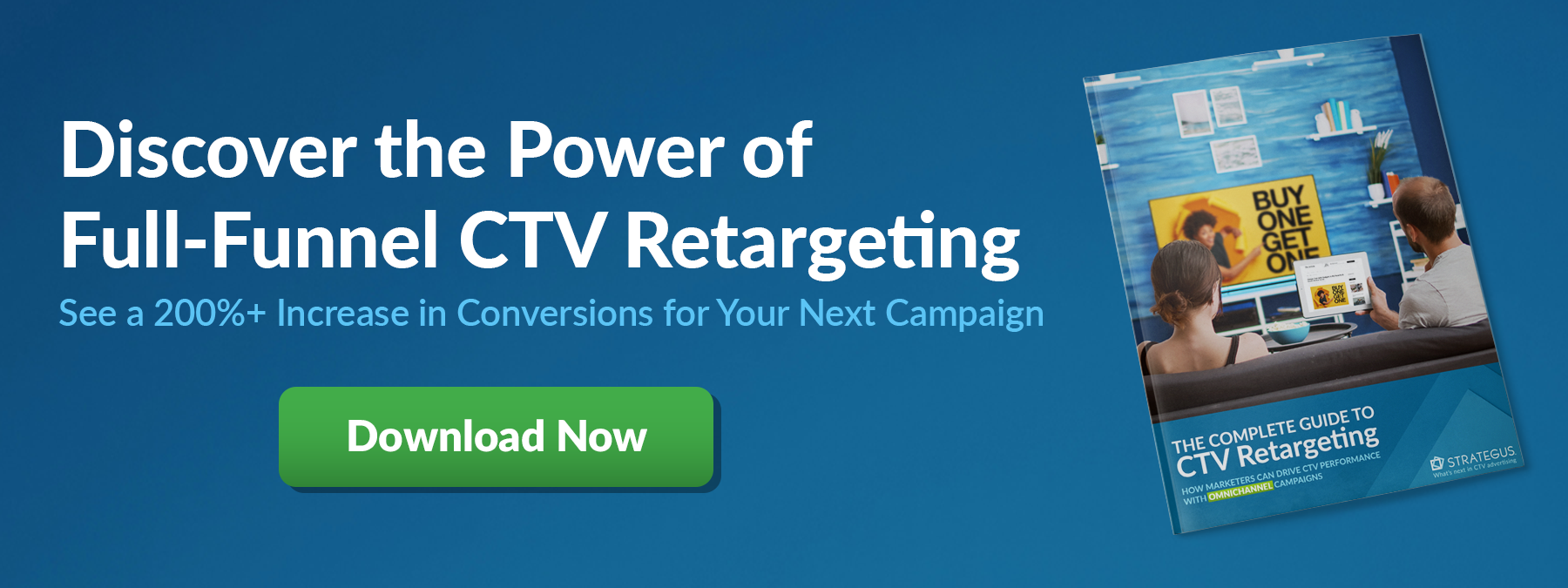- Home
- Strategus Blog
- The History of Commercials and TV Advertising
The History of Commercials and TV Advertising
 Traci Ruether
Traci Ruether
10 minutes read

Picture this: It’s a sunny day in July and the year is 1941. A family in New York City sits down to watch the Brooklyn Dodgers play the Philadelphia Phillies on their brand-new television. They own one of the 4,000 TV sets in the city at that time.
Right before the ball game begins, an ad plays for the Bulova Watch Company. The simple spot combines a static graphic with a live voiceover, declaring “America runs on Bulova Time.”
As the world’s first TV commercial, the 10-second ad changes marketing forever
The commercial, which aired on the NBC-owned station WNBT, cost Bulova a whopping $9. And yet, it marked the beginning of a multi-billion dollar market: TV advertising.
Radio advertising still dominated the airwaves at the time. But that would all change in a matter of years. TV was quickly gaining dominance over the radio, and the ability to entice customers with moving pictures showed a lot of promise.
Fast forward to today (when we have the literal ability to fast-forward through commercials), and TV advertising has shaped our society. Countless jingles, slogans, and characters have come to life during commercial breaks. Without TV ads, there'd be no Flo from Progressive or Geiko Gekko. “Dilly Dilly” and "Wazzup" would be absolute gibberish. And who knows if Snuggies would have ever caught on?
The TV advertising space has evolved drastically in its 80-year lifespan. Today, viewers are more likely to stream content delivered to connected TVs (CTV), bringing new approaches to advertising altogether.
While commercials once operated on a “spray and pray” model — where businesses would broadcast generic messaging to large groups in hopes of reaching a handful of prospects — programmatic advertising now allows marketers to reach targeted audiences with relevant messages.
In this article and infographic, we take a look at the history of commercials and where the future of advertising is headed. Hold on to your hats, it’s a wild ride ahead.
 Learn More→ OTT Advertising Trends in 2023
Learn More→ OTT Advertising Trends in 2023
1941-1955: TV Advertising Is Born
In June of 1941, the FCC lifted its ban on TV advertising, and commercials hit the airwaves one month later. The ad for Bulova watches above became the first commercial on television — or at least the first legal one. Any TV advertising tests that aired before weren’t compensated due to regulations.
U.S. advertisers continued experimenting with the medium, and in 1949, Vitamix was featured in the world’s first infomercial. Vitamix founder “Papa” Bernard leveraged his background as a salesman to host a live half-hour product demonstration of his cutting-edge blender. He needed to sell 18 machines to break even on ad costs. In the scope of a single night, he sold 400.
Outside of the U.S., marketers followed suit. A 1953 ad for Seiko watches brought TV advertising to Japan, succeeded by a 1955 Gibbs SR toothpaste advert in the United Kingdom.
With watches, toothpaste, blenders, and more finding success on the small screen, advertisers started expanding their horizons. What came next was Eisenhower’s 1952 commercial for the presidential race — bringing political advertising into the fold. The “Ike for President” jingle would go on to define Eisenhower’s win in the first U.S. election where TV played a role.
By 1955, television had ousted radio as the primary source of entertainment in U.S. homes. It would also soon replace newspapers as the primary news source, which meant advertisers had no choice but to embrace the new medium.
1956-1988: Commercials Become Engrained in Our Culture
At the end of the 1950s, we entered the Golden Age of Advertising. Agencies began approaching commercials as an art form in their own right and things started to get exciting. The explosion of spending in the industry didn’t hurt either. This is when Mad Men-esque creative complemented popular entertainment like I Love Lucy and The Ed Sullivan Show. Commercials were still novel enough to capture viewers’ attention, and advertisers rose to the occasion.
In 1963, Ronald McDonald got his start in a series of spots that would scare most children today. A decade later, the Oscar Mayer “My Bologna Has a First Name” song debuted, which continued to play in their commercials until 2010.
Other popular jingles, characters, and slogans from commercials during this period include:
-
The Pillsbury Doughboy, airing in 1965
-
The Tootsie Pop “How Many Licks” campaign, airing in 1968
-
Nike’s “Just Do It” campaign, airing in 1988
By the 1980s, TV advertising was big business — with ABC, CBS, and NBC earning more than $4 billion in revenue. And so, Apple aired its iconic Macintosh commercial during the 1984 Super Bowl with a $500,000 spot. This is the point at which the annual football game became a major ad event. It’s also the beginning of an era where ads could double as breaking news.
1989-2006: The World of Online Entertainment and Advertising Comes Alive
Right around the time that the Berlin Wall fell, scientists were transcending global borders in another way entirely. It was in 1989 that the British scientist Tim Berners-Lee invented the World Wide Web.
He intended to streamline information sharing between institutions and universities around the world. The impact that the internet would have on entertainment, advertising, and everyday life wouldn’t be realized for some time — but we all know how things panned out.
Technology moved fast during this period. The first broadcast was streamed online just four years later. A group of Silicone Valley scientists with a garage band called Severe Tire Damage were the architects of this stream, which used up half of the internet’s available bandwidth at the time.
And so, the groundwork was laid for online video broadcasting. But what about online advertising? In a matter of one year, online advertising arrived in the form of an AT&T banner ad.
YouTube put the two together in 2006 by launching its first ad concept. This was the point at which ad-supported streaming became an industry in its own right.
2007-2014: OTT Services and CTV Devices Are Brought to the Masses
The period from 2007 through 2014 saw a frenzy of activity in over-the-top (OTT) broadcasting and connected television (CTV) innovation. It all started when Netflix pivoted from mailing DVDs to subscribers to streaming content directly to their living rooms. Internet video had found its place in mass media.
This disrupted the broadcast industry in a number of ways. For one, viewers were no longer shackled to a fixed broadcast schedule. Beyond that, the Netflix subscription-based video-on-demand (SVOD) model left advertisers out of the picture.
Luckily, that didn’t last long. Hulu launched its ad-supported streaming platform the following year. That meant advertisers could still reach viewers watching shows at home, and the CTV advertising industry was born.
Televisions became increasingly smart. LG, HP, Samsung, and Sony all developed connected TV sets, bringing the internet into living rooms. Similarly, Roku released its set-top box, transforming any TV set into a smart, connected device.
2015-2022: CTV Advertising Thrives as Cord-Cutting Becomes the Norm
Strategus pushed TV advertising into a new frontier by delivering the first programmatic CTV ad in 2015. The campaign, which targeted consumers already in the market to buy a car, served ads for an auto agency that still partners with Strategus today.
The beauty of CTV advertising lies therein: Rather than broadcasting expensive and irrelevant commercials to countless viewers, programmatic CTV allows businesses to reach likely buyers with sophisticated campaigns.
Take it from our EVP of Innovation & Strategy and Co-founder Joel Cox:
“Programmatic advertising brings new capabilities to more mid-market companies who can now afford more precise targeting, and therefore more accessible budgeting and reach. The opportunities for more advertisers are democratized by new technology. We want to move the market more toward where it should go, where ads are targeted to individuals in the audience, who see ads that are relevant to them, as opposed to the old way, where ads are targeted more toward the content that people are watching. The data-driven approach makes so much more sense as the content is exploding with digital streaming over the internet. Serving relevant ads to the right people at the right time is where the advertising industry has wanted to go for generations.
Since running the first CTV ad, we’ve watched ad-supported streaming become widespread. Following Hulu’s success with the AVOD model, Netflix and Disney+ both added advertising into their business models last year.
Beyond that, free ad-supported TV (FAST) is displacing linear satellite and cable. Top players in the FAST space include Roku, Pluto TV, and Peacock. This combination of streaming and traditional linear broadcasting delivers channels at no cost to cord-cutters.
As a result, streaming has finally surpassed linear cable in viewership. To put this another way: if you aren’t advertising to CTV viewers, you’re missing out on the biggest slice of the pie.
2023 - Present Day
We've traded in our bulky televisions for sleek connected TVs, and swapped generic commercials for targeted programmatic advertising. So what's next? It’s impossible to say.
Will VR change the future of advertising, or has the promise of the metaverse fizzled out? What about AI? Is it going to transform video production as we know it?
Regardless of these unknowns, two things are clear: TV advertising is here to stay and the future of streaming is ad-supported.
Strategus has been pioneering CTV advertising since its inception and we’re continuing to innovate faster than recent adopters. If you’re looking for a partner to make sure your ads reach the right viewers, at the right time, with the right message — look no further.
Find out what else is ahead by reading our blog on OTT Trends in 2024 or contact us today to get started.

Traci Ruether is a content marketing consultant specializing in video tech. With over a decade of experience leading content strategy, she takes a metrics-driven approach to storytelling that drives traffic to her clients' websites. Follow her on LinkedIn at linkedin.com/in/traci-ruether or learn more at traciruether.com.
Strategus is a managed services connected TV(CTV) advertising agency with over 60,000+ campaigns delivered. Find out how our experts can extend your team and drive the result that matter most.
Talk to an Expert
Seeking a Custom CTV Strategy That Delivers?
What to read next

Third-Party Data Targeting for CTV: Benefits & Tactics
Third-party data. It’s a term that’s thrown around, and yet few take the time to detail its pros and cons — much less strategies for using...
7 minutes read

First-Party Data Targeting: Benefits and Tactics for CTV Advertising
First-party data is the information that companies collect directly from their customers rather than through intermediaries. Advertisers use this...
10 minutes read

Foot-Traffic Attribution: Tying Ad Impressions to In-Store Visits
The marketing funnel has changed. Today’s shoppers often begin researching products from the comfort of their homes and don’t set foot into a store...
8 minutes read

CTV Attribution: What It Is and How It Works
Connected TV (CTV) viewing is on the rise — and that’s good news for marketers. Not only can CTV ads be precisely targeted to individual households,...
9 minutes read
















